May 3 - 9, 2015: Issue 212
Pittwater: Lovely Arm of the Hawkesbury
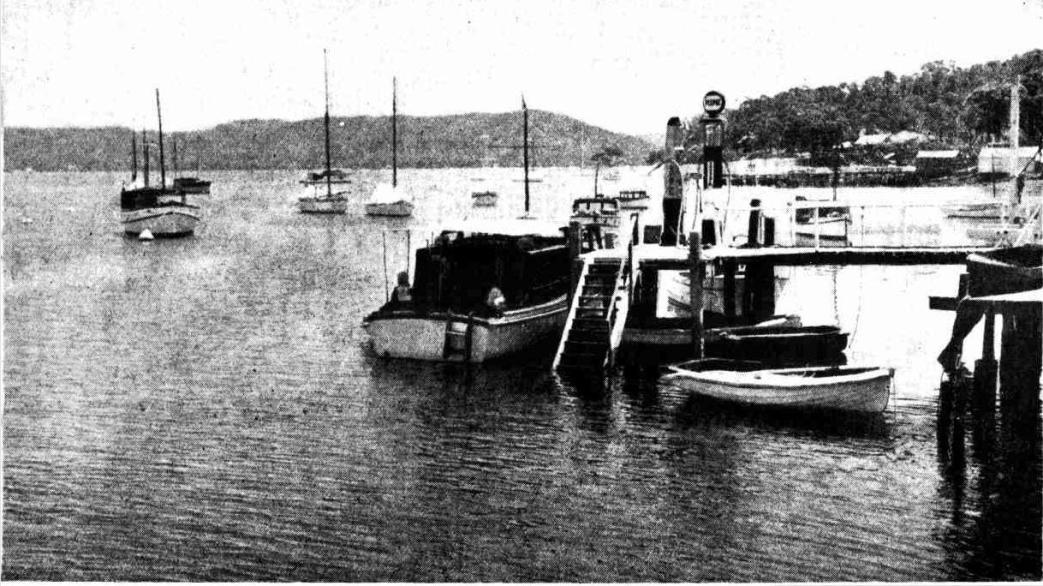
The pier at Pittwater, local 'headquarters' of the yachting and sailing fraternity.
Pittwater: Lovely Arm of the Hawkesbury
By NOEL GRIFFITHS
I HAVE before me a map of Pittwater, showing every bay and point, every beach and wharf and creek. This much-used map is not crowded with detail, but is just sufficiently complete to satisfy all the requirements of an imaginative mind. There is, in fact, all the material for the background of a novel— aboriginal lore, tales of pioneers, of piracy and smuggling, hidden treasure, shipyards and sailing races.
SEE, here at the mouth of Broken Bay, is Lion Island, officially known as 'Mount Elliott,' but its more popular name will live after the other is forgotten because of the island's amazing resemblance to a lion couchant. And here is Barrenjoey. Where the well constructed lighthouse now stands with its fixed white light, visible for fifteen miles, there was once only afire basket and a tall white pillar.' At that time smugglers crept round into Pittwater, for it was easy to discharge contraband there and send it to Sydney without paying duty. So serious did this illegal traffic become that, after the detection of a vessel aptly named the Fair Barbarian engaged in, this illicit trade, a Customs officer was stationed on the .inner beach near the headland to report suspicious happenings. To bluff intending smugglers, this ingenious officer constructed a tall wooden soldier equipped with a drawn sword, to suggest, armed vigilance, but, alas, an irate skipper mistook the intention and hurriedly put ashore to 'rescue' the redcoat who was signalling in distress.
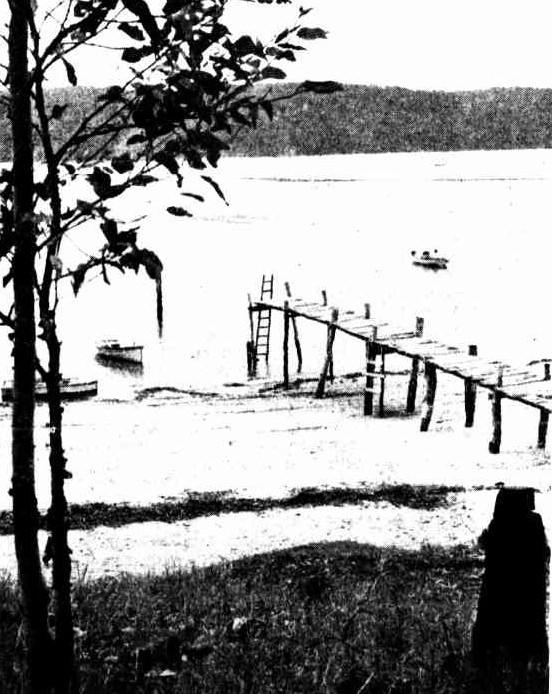 IT is hard to believe that in this serenely beautiful spot piracy preceded smuggling, yet we are told by Collins in his 'Account of the English Colony at –Port Jackson' that in September, 1797 —'A boat, the largest and best in the Colony, belonging to the government, was, on her passage to the Hawkesbury, whither she was carrying a few stores, taken possession of by a part of the boat's crew, being at the same time boarded by a small boat from the shore, the people in which seized her and put off to sea, first landing the coxswain and three others, who were unwilling to accompany them, in Pitt Water in Broken Bay. These men proceeded overland to Port Jackson, where they gave the first information of this daring and 'piratical transaction.' But there are earlier historical references to Pittwater even than that. In fact, in Governor Phillip’s first despatch from the settlement at Port Jackson to Lord Sydney he recounts how on 2nd March, 1788, he set off to explore Broken Bay, about twenty miles north, in an urgent search for land suitable for cultivation, and came across: '. . . . the finest piece of water I ever saw and ' which I honoured with the name of Pitt Water.* Wm. Pitt the younger was at that time Prime Minister of England. It would contain the navy of Great ' Britain'.
IT is hard to believe that in this serenely beautiful spot piracy preceded smuggling, yet we are told by Collins in his 'Account of the English Colony at –Port Jackson' that in September, 1797 —'A boat, the largest and best in the Colony, belonging to the government, was, on her passage to the Hawkesbury, whither she was carrying a few stores, taken possession of by a part of the boat's crew, being at the same time boarded by a small boat from the shore, the people in which seized her and put off to sea, first landing the coxswain and three others, who were unwilling to accompany them, in Pitt Water in Broken Bay. These men proceeded overland to Port Jackson, where they gave the first information of this daring and 'piratical transaction.' But there are earlier historical references to Pittwater even than that. In fact, in Governor Phillip’s first despatch from the settlement at Port Jackson to Lord Sydney he recounts how on 2nd March, 1788, he set off to explore Broken Bay, about twenty miles north, in an urgent search for land suitable for cultivation, and came across: '. . . . the finest piece of water I ever saw and ' which I honoured with the name of Pitt Water.* Wm. Pitt the younger was at that time Prime Minister of England. It would contain the navy of Great ' Britain'.
RIGHT: A Paradise for the boating man and the fisherman, yet near enough to the city to be easily accessible, Pittwater is a much frequented resort in holiday-time.
Phillip described in this despatch his encounters with the natives, one of whom proved friendly and helpful, .. but when Phillip chided him with the theft of a spade 'this destroyed our friendship in a moment and seizing a spear he came close up to me, poised it and appeared determined to strike.' But Phillip fixed him firmly with his gaze, for he chose 'rather to risk the spear than fire on him,' so that at last the native capitulated and, dropping his spear, left.
When the natives discovered that Phillip was minus a top tooth there was a great clamour, and the loss gave him some merit in their eyes, because the forcible removal of one of their own front teeth was an indication that they had attained manhood and the status of warrior.
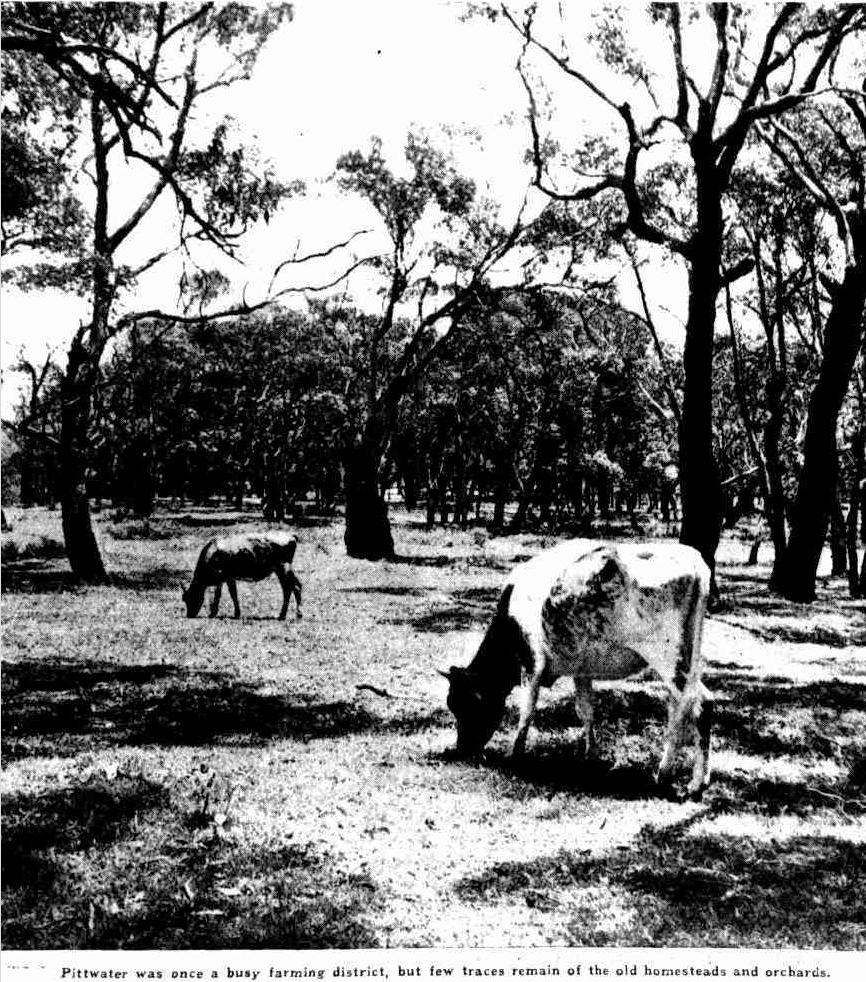
Pittwater was once a busy farming district, but few traces remain of the old homesteads and orchards.
LONG after the district was settled the aborigines proved troublesome, and present-day residents whose grandparents pioneered it describe how the 'Barrenjuee' tribe roamed the bush by day, calling at lonely bark and split-log shanties when the husband was away, demanding flour and tobacco of some lonely girl-mother who kept a musket near the door for her protection. At night these black marauders 'bandicooted' the crops of potatoes and stole the settlers 'maize. Slowly vanishing memorials to this large and troublesome tribe are their rock carvings on the headlands of Kuring-gai Chase and their middens, great heaps of oyster, whelk and cockle shells.
As the settlements on the Hawkesbury flourished, so Pittwater grew in importance. It was a port of call for vessels bound for Sydney. Mails came from the north, via Gosford and Brisbane Water, to the wharf at Newport. Farms on the foreshores produced grain, vegetables, and butter. Shipbuilding began to rival farming in importance. There were shipyards at Stoke 's Point, Scotland Island and McCarr's Creek. On Scotland Island, so it is recorded, is buried a three-legged pot full of 'holey' dollars, hidden by two men who came down the river in a stolen boat, laden with booty. These men, it is said, were arrested at Pittwater and sent back to confinement, never to return to retrieve their loot.*
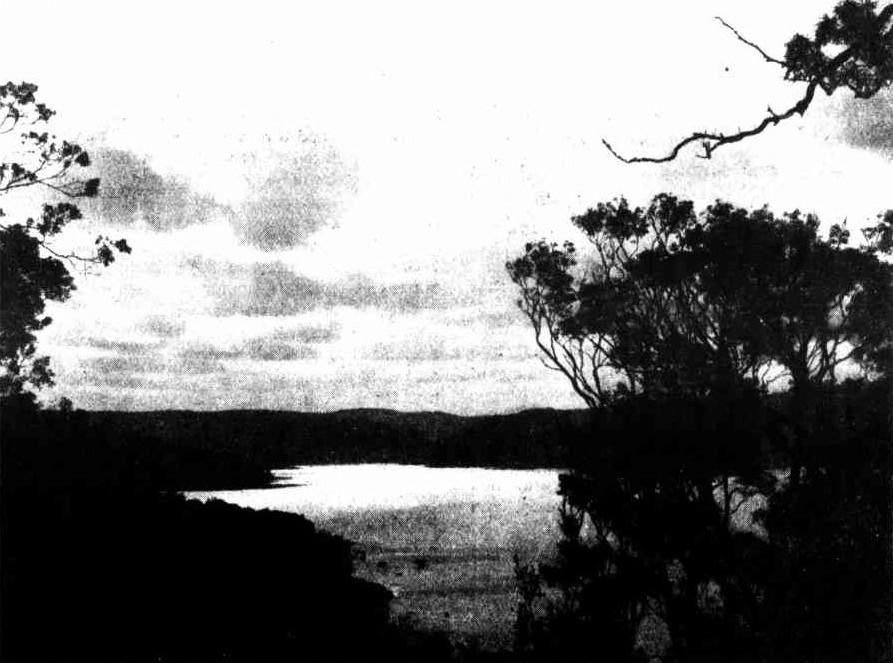
When the sun is setting behind Pittwater Nature is seen in one of her most peaceful moods.
PITTWATER has lost most of its economic importance since those stern days when sloops were tediously built on the different points and great logs of timber were hauled from the nearby woods, when there was a salt works on 'Salt Pan' Creek and Ah Chuey ran a flourishing fish-drying business near Careel Bay. Bu tit has gained a new importance. Boats are still built on its foreshores — luxurious pleasure craft in sheds crammed with a wonderful assortment of masts, chains, canvas, spars, paint, and cordage. And in those peaceful, secluded retreats boats are being scraped, cradles made, masts repaired, and sweet-running engines overhauled. Here are sunburnt men who carry on the traditions of a century and more who, if not lineal descendants, are worthy successors of the stout-hearted pioneers; men like Gus, the Swede, who lives on his launch and occasionally signs on for a cruise to the Barrier Reef — a man of Viking strain, holder of a mate's certificate, too old now for an active life, but who can't escape the lure of lapping water beside a boat or the tang of fresh salt breezes in his nostrils. Then there's Billie ? , who has fished The length of Pittwater for forty years or more, who knows every bend and nook of it and can read its every mood. When a southerly blows and ruffles its surface he is dull and listless, but when a sharp 'nor'-easter' sweeps across the hills he is all activity — fish will be plentiful and in no time he'll be chugging past Great Mackerel Beach with its two uncharted graves, past the Basin, past Soldiers' Point. Soon the bucket in his launch will be filled with bream and leather-jacket, flounder, mackerel and whiting. He'll 'threadle' his hooks as he goes along, with juicy earthworms from near the mangrove swamps, for the fishing itch is in his makeup and will be till he dies.
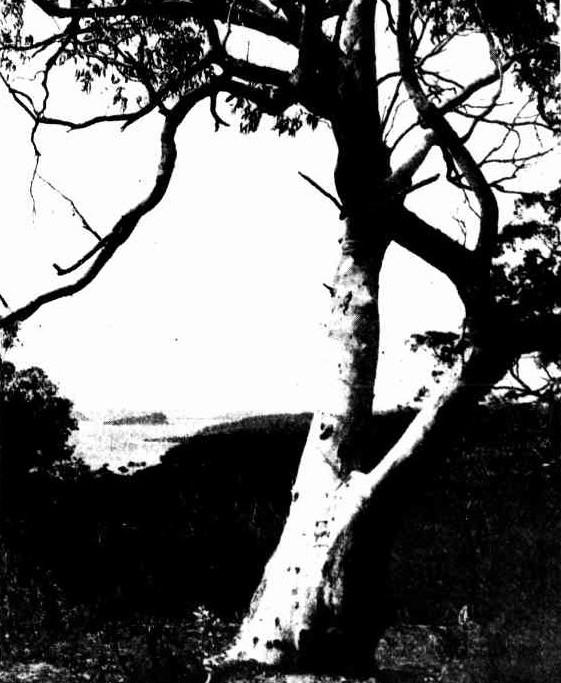 RIGHT : A view with a glimpse of Lion Island (officially known as Mount Elliott). This is one of the most beautiful vistas on the coast.
RIGHT : A view with a glimpse of Lion Island (officially known as Mount Elliott). This is one of the most beautiful vistas on the coast.
THE great occasion of the year at Pittwater is the annual regatta, when the week-end cottages nestling cosily at the water's brink all spring to life. The hundreds of neat white craft, riding at their moorings, assume a new activity. Boats are pushed out and sails unfurled, hydroplane engines 'rev.' and roar, and soon the blue stretch is graced with gleaming sails which sweep majestically past while luxurious cruisers plough importantly towards the club house. On them will be seen happy, charming girls and sun-bronzed men and older men with grizzled hair and keen blue eyes, and robust, clean-limbed youngsters growing up in the best traditions of yachting and cruising and a glorious outdoor life. Aye, it is a kind retreat, this beautifully clothed arm of the Hawkesbury. It is good to tramp its shores, to penetrate the almost virgin bush where wattle, waratahs, Christmas bells and flannel flowers luxuriate ;to lie on some green, shady slope and watch the sun scintillating on its broad expanse the while large white clouds float majestically high above tall and stately trees. It is the peaceful playground of a busy city; meet place to retire to adjust one's perspective when work grows wearisome and details assume quite wrong proportions. A sunset behind Church Point, the vicious tug and flurry of a fish on the end of a well-baited line, the strong caress of wind against a sail, the tense moment after the skipper's curt 'prepare to go about,' bump and scrape of fender against wharf — and life resumes its zest again.*
AS I have said, it is an ideal background for a book... if you can resist the lure of it and settle down to work.
The serene appearance of Pittwater to-day conveys no suggestion of its turbulent past, though visitors blessed with imagination do not find it difficult to conjure up visions of long - dead smugglers, pirates, and revenue, officers. Some bad men plied these waters in the 'good old days,' and the local bushland was peopled by warlike blacks, who harried the settlers and stole everything they could lay hands on.
*See Vol. VI. (1920) Inl. and Proceedings of the Royal Australian Historical Society.
Pittwater:. (1938, December 28). Sydney Mail (NSW : 1912 - 1938), p. 12. Retrieved from http://nla.gov.au/nla.news-article166525296
_________________________________
Noel Griffiths was the Public Relations Institute of Australia's Foundation President in 1952. His pioneering work has been honoured for many years by the Noel Griffiths Lecture.
He was associated with Asher Noel, later Sir, who was the Founding Member. Sir Asher Alexander Joel KBE, AO (4 May 1912 – 12 November 1998) was a member of the New South Wales Legislative Council for 20 years. During the Second World War, he enlisted in the Australian Army in 1942, then transferred to the Royal Australian Navy, joining the staff of General Douglas MacArthur between 1944 and 1945.
General Douglas MacArthur (Commander in Chief, Allied Forces – Pacific Region) was the first person to introduce the term 'Public Relations' to Australia accordng to some sources, in 1942 and known for being a professional communicator, using public relations personnel to promote both his own personal image and his war policies.
By 1947 there were two registered public relations consultants in Sydney: George Fitzpatrick Pty Ltd and Mr A. A. Joel (later Sir Asher Joel).
In 1949, Sir Asher Joel and Mr Noel Griffiths began working towards having public relations practice recognised as a profession, and the Australian Institute of Public Relations was formed later that year.
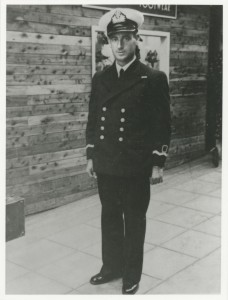 Sir Asher Alexander Joel KBE, AO was elected to the New South Wales Legislative Council as an Independent, but joined the then Country Party (now the National Party) the following year. In 1971-1972, he served as party treasurer, and in 1971, he served on the central executive. He retired from the Legislative Council in 1978. He was the first Australian Jew to be made a Papal knight, was twice knighted by the Queen in 1970 and 1973 and was awarded the Order of Australia medal in 1986.
Sir Asher Alexander Joel KBE, AO was elected to the New South Wales Legislative Council as an Independent, but joined the then Country Party (now the National Party) the following year. In 1971-1972, he served as party treasurer, and in 1971, he served on the central executive. He retired from the Legislative Council in 1978. He was the first Australian Jew to be made a Papal knight, was twice knighted by the Queen in 1970 and 1973 and was awarded the Order of Australia medal in 1986.
At the age of 14, he went to work as a copyboy at the Daily Telegraph. He became a reporter and worked on The Labor Daily, until, before he was 20, he became their parliamentary roundsman. His political reporting was so skilful that before long he was in public llife as publicity director for the coronation of George VI and the 1938 sesquincentenary. A year later he organised Australia's 150th Anniversary Celebrations.
Later on he published his own newspaper, the North West Star, which circulates in Mount Isa, Queensland, and is distributed over an area of 400,000 square kilometres.**
In 1975, he established the Sir Asher Joel Foundation to assist Macquarie University students to participate on archaeological digs with Tel Aviv University, and during the course of his career, he helped to organise a number of large-scale events, acting in an honorary capacity: the visit of Princess Alexandra of Kent in 1956; the visit of U.S. President Lyndon B. Johnson in 1966; the visit of Pope Paul VI in 1970. Sir Joel was also heavily involved with the establishment of the Sydney Opera House.*
Noel Griffiths wrote on a number of subjects for many local papers, including Sydney Mail, Sydney Morning Herald and The World's News (Sydney) for decades. He was a strong advocate for rural people throughout his career, holding the position of president of the Australian Council of Young Farmers for several years.
He was a strong advocate for Integrity in Public Relations and involved in the setting up of a Code of Ethics for this industry in 1959. Journalists sought extra work in this field following the close of the newspaper The Argus (Melbourne) in 1957 and the boom in information services where many companies began creating Public Relations departments and officers in post-war Australia required a re-think on how best to do things.
Besides making politicians best lights shine under public scrutiny, writing articles for dailies and weeklies, some of which were clearly collected while performing his duties as president for the Young Farmers, Mr. Griffith also wrote papers that are still referred to today on Public Relations and Media in Australia. He remains a standard looked to for those who want to share correct information, without sensationalism, to attract the right kind of sponsorship, and was well-known for his clear and precise diction.
A little more on this gentleman:
Farmer Team Specialists' Reports
Technical reports of the members of the Rural Bank's Progressive Farmer Team have just been published, reports the Rural Bank of New South Wales. The team which was chosen by state-wide competition, toured America, Canada, and the United Kingdom to study latest developments in crop and livestock production and marketing of farm products. The reports are: 'Mixed 'Farming in North America and the United Kingdom', by W. A. Meares; 'Dairy Farming in North America and the United Kingdom'. by M. R. Buttsworth; 'Poultry Farming in North America and the United Kingdom', by W. H. Bruce: 'Rural Youth', by Noel Griffiths, Public Relations Officer of the Bank and manager of the team. Farmer Team Specialists' Reports. (1949, October 5). The Gosford Times and Wyong District Advocate (NSW : 1906 - 1954), p. 4. Retrieved from http://nla.gov.au/nla.news-article167109599
J.F. PRESIDENT - Mr. Noel Griffiths, Public Relations Officer of the Rural Bank, has been elected president of the Junior Farmer Clubs’ State Council in succession to Mr. E. Breaknell who was ineligible for re-election, having served a two-ygai1 term. Mr. Griffiths was manager of the Rural Dank Progressive Farmer Team which toured North America and the United Kingdom in 1948. J.F. PRESIDENT. (1950, May 24). The Manning River Times and Advocate for the Northern Coast Districts of New South Wales (Taree, NSW : 1898 - 1954), p. 5. Retrieved from http://nla.gov.au/nla.news-article172832937
Junior Farmers. New President Takes Keen Interest In Work For Rural Youth ;
(By 'Corncob')
 KEENNESS in work among rural youth shown by Mr. Noel Griffiths over several years can be taken at a guide that the Junior Farmer Club movement in this State will continue to progress. Mr. Griffiths recently was elected president of the Junior Farmers Clubs' Council of N.S.W. He succeeded Mr. E. Breakwell, founder of the movement, who retired after holding office for two years.
KEENNESS in work among rural youth shown by Mr. Noel Griffiths over several years can be taken at a guide that the Junior Farmer Club movement in this State will continue to progress. Mr. Griffiths recently was elected president of the Junior Farmers Clubs' Council of N.S.W. He succeeded Mr. E. Breakwell, founder of the movement, who retired after holding office for two years.
Mr. Griffith is public relations officer of the Rural Bank and has represented the Bank on the Council for 10 years. He has been a vice-president since the end of the war. Before joining the Rural Bank as advertising manager in 1935, Mr. Griffiths was similarly employed by Nestles (Aust.) Ltd. He was appointed to his present position early in 1945 on his return from the war during which time he served in New Guinea on the headquarters staff of the 11th Australian Division as major. In 1948 he went overseas a manager of the Progressive Farmer team of three who had won the Rural Bank's State-wide contest. The team spent six months studying farming problems in the United States, Canada, and Great Britain under the guidance of Mr. Griffiths and Mr. C.P. Dowsett, assistant economist of the Bank.
Mr. Griffiths has many other Interests, being honorary public relations officer of the N.S.W. Bush Fire Advisory Committee and an active member of the Rostrum Movement. This movement is to assist those who wish to advance themselves In the art of public speaking, Its work Is certainly reflected in Mr. Griffiths, who has faultless speech. Mr. Griffiths said the J.P.C. executive was meeting regularly to keep the movement abreast of latest developments of modern agriculture. Among Immediate plans for Improvement is a scheme to make the organisation self-dependent for finance through clubs without relying for support from outside sources. The question of raising the age limit to 25 years Is being considered. Revision of certain projects and the job of making the movement more unified will be tackled. But In the capable hands of Mr. Griffiths these problems should not be too difficult. His enthusiasm for the work of Junior Farmer Clubs Is well known and the movement In N.S.W. Is sure to go ahead as long as he Is associated with It. Junior Farmers. (1950, August 4). The Farmer and Settler(Sydney, NSW : 1906 - 1957), p. 20. Retrieved fromhttp://nla.gov.au/nla.news-article117397358
VICE.REGAL. His Excellency the Governor General, the Rt. Hon. Sir William McKell, received at Admiralty House, Sydney, yesterday morning Mr. R. G. John Clarke, president, Mr. C. Bennett Bremner and Mr. Asher Joel, vice presidents, Mr. F. C. Barnes, hon. treasurer, Mr. D. Barnes, hon, secretary, and Mr. Noel Griffiths, past president, of the Australian Institute of Public Relations. VICE-REGAL. (1952, April 18). The Sydney Morning Herald(NSW : 1842 - 1954), p. 2. Retrieved from http://nla.gov.au/nla.news-article18254875
*Asher Joel. (2015, April 13). In Wikipedia, The Free Encyclopedia. Retrieved from http://en.wikipedia.org/w/index.php?title=Asher_Joel&oldid=656256150
**Sir Asher Joel, politican and businessman (1912-1998) Judaica Library:University of Sydney. Retrieved from http://judaica.library.usyd.edu.au/histories/AsherJoel.html
Pittwater: Lovely Arm of the Hawkesbury By NOEL GRIFFITHS - includes RMYC Wharf and Clareville Wharf of 1938 + An Insight into Public Relations in Australia - threads collected and collated by A J Guesdon, 2015.